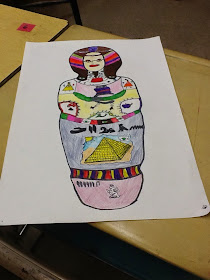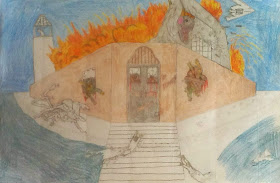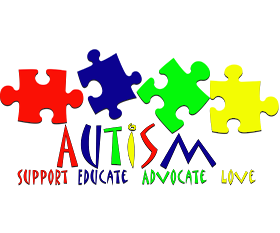Here's another post I've written about autism in the art room.
Pages
▼
Saturday, December 27, 2014
An Art Lesson For My K- 2 Autistic Students
Sunday, December 7, 2014
How To Draw Aztec Sun Stones
Math Connections In Art Class
Concentric Circles
We start out drawing 4 concentric circle. They're given the sizes for the inside and outside (1st & 4th) circles. They have to come up with the measurements for the two inside circles.
After that, they design the sun face inside the center circle. They can add eyelids, eyebrows, eyelashes, cheeks etc. Their choice.
I swear, some of the designs for the faces they come up with are amazing!!!
My only requirement for the sun face is that the tongue is sticking out. On the original, ancient Aztec sun stones it was actually a knife sticking out of the mouth. (FYI- don't tell them this!) I tone this down a little and require a tongue to be sticking out.
I swear, some of the designs for the faces they come up with are amazing!!!
My only requirement for the sun face is that the tongue is sticking out. On the original, ancient Aztec sun stones it was actually a knife sticking out of the mouth. (FYI- don't tell them this!) I tone this down a little and require a tongue to be sticking out.
Geometric Shapes
For this project, I require that the kids draw patterns with geometric shapes. So the next thing we do is talk about the definitions of geometric shapes vs. organic shapes. And we also talk about what a pattern is.
On the second concentric circle, the kids are asked to draw some kind of sun ray pattern around the face. Repeated rectangles or triangles of various sizes, work just fine for this section. But, as long as it's geometric, the sun ray pattern is all their own!
After that, the kids get to start drawing their geometric patterns in pencil on all the other concentric circles.
Sunday, November 30, 2014
Portraits- With A Colorful Twist
Oh, and here's the bulletin board I created with these. It was titled 'Look what happens... when you eat a box of crayons!!!'
Friday, November 28, 2014
How To Make An 'Egyptian' Mummy
Ancient Egypt is one subject that the kids always love to learn about in art class. Who can't resist a good mummy story!
The whole history of pyramids, pharaohs and mummies can be quite fascinating. I have a few different versions of making mummies, but the following is one my favorites.
We start out reviewing the whole history of the pyramids, the ancient Egyptian religious system, with their gods and goddesses, and the mummification process. After that we're ready to make our mummies.
The kids then get an overview of Egyptian hieroglyphics system. They have to write a word at least 5 letters long, using the hieroglyph symbols, that they put on somewhere their mummy. Either horizontal or vertical.
They then have them make up 3 'hieroglyph' symbols of their own, that they add to their mummy. The Egyptian Hieroglyphs symbols were representation of objects important to Egyptian life- things such as water, loafs of bread, grass reeds, etc. The kid- designed 'hieroglyph' symbols should be objects important to their life.

Other things they are required to add to their mummies are- some kind of a crown, a few strands of jeweled necklaces and jewels in their hair. The mummies needed this to make sure they didn't lose their social status in the afterlife. So they were buried in their 'bling'.
Below are a couple of mummies that kids designed in their 'own' style. Some times I let the kids do that if they're really creative and have a vision of how it will be differentiated. Once in a while you gotta let the kids go their own way! Use some discretion and give 'em a little leeway. I think these came out really nice.
What do you think of our Egyptian mummies? Would they work in you art room? I'd love to hear what you think about them. You can comment below.
Saturday, November 22, 2014
How To Draw 2 Point Perspective Castles
 |
| A work in progress |
What do you think of this 2 point perspective project? Do you have a castle project that works in your art class? I'd like to hear about it in the comments below.
Thursday, October 30, 2014
Autism In The Art Room

I recently went to a work shop for art teachers on autism that was presented by The Autism Project. The workshop helped me become aware of the challenges these kids face due to their disability. I want to share what I learned with you.
Here are 10 things that a person with autism wishes you know about them (and may not be able to express) while they're in your art class.
1. I'm a person trying to be happy and successful in school. But social situations are hard for me. I struggle to join and be part of a group.
2. My sensory system isn't reliable.
3. Sometimes I can't do what you're asking. It is not because I don't want to.
4. I'm a concrete thinker. It's hard to be flexible when things are different than how I thought they would be. Sometimes I don't understand other views or choices available. I get easily stuck.
5. Communication is hard for me. I can hear words, but I don't always understand your message. Also, I have a tough time telling you what I'm thinking and feeling. Sometimes, I need extra time to find the words in my head.
6. I learn best with my sense of sight.
7. I'm great at many different things.
8. Waiting is difficult for me. I live in the present.
9. It is hard for me to hold my feelings in when I'm anxious or angry. I can have meltdowns, tantrums or withdraw.
10. Accept me for me; I will accept you for you.
What are some strategies we can use to help our autistic students who will eventually be a part of our art class?
*Be consistent
*Have routines and be predictable
*Have as few transitions as possible
*Have a visual schedule of tasks to be done in class
*Have close end tasks or projects with a clear finish
I hope there's something here that will work for you in your art class. If you know of any other tips, strategies or supports for autistic students in the art class, I'd like to hear about them.
Here's a simple lesson with a literacy component I use in my autistic art class. Check it out here.
Sunday, October 26, 2014
3 Helpful Apps For The Travelling Art Teacher
Thursday, October 9, 2014
Printmaking With Recyclables
The next step is you're ready to print! All you need is a lesson idea.
I chose to use these printers to create textured skin on an chameleon lesson.
First, draw your chameleon. For this lesson, I used the chameleon drawing template from the website Art Projects For Kids.
The bumps from the foam makes the texture on the chameleon's skin start to appear.
You can add another color. You can even add another texture, if you chose a different style of foam on your printers.


































